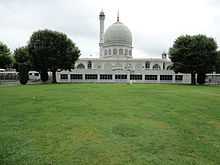Hazratbal Shrine

The Hazratbal Shrine (Kashmiri: हज़रतबल (Devanagari), حضرت بل (Nastaleeq), translation: Majestic Place), is a Muslim shrine in Srinagar, Jammu & Kashmir, India. It contains a relic, the Moi-e-Muqqadas, believed by many Muslims of Kashmir to be a hair of the Islamic prophet Muhammad. The name of the shrine comes from the Arabic word Hazrat, meaning holy or majestic, and the Kashmiri word bal, meaning hair.
The shrine is situated on the left bank of the Dal Lake, Srinagar and is considered to be Kashmir's holiest Muslim shrine.[1]
History of the relic
According to legend, the relic was first brought to India by Syed Abdullah, a descendant of the Islamic prophet Muhammad who left Medina and settled in Bijapur, near Hyderabad in 1635.[citation needed] When Syed Abdullah died, his son, Syed Hamid, inherited the relic.[citation needed] Following the Mughal conquest of the region, Syed Hamid was stripped of his family estates. Finding himself unable to care for the relic, he sold it to a wealthy Kashmiri businessman, Khwaja Nur-ud-Din Eshai.[citation needed]
However, when the Mughal Emperor Aurangzeb came to know of what had transpired, he had the relic seized and sent to the shrine of Khwaja Moinuddin Chishti at Ajmer, and had Khwaja Nur-ud-Din Eshai imprisoned in Delhi for possessing the relic.[citation needed] Later, realizing his mistake, Aurangzeb decided to restore the relic to Khwaja Nur-ud-Din Eshai and allowed him to take it to Kashmir.[citation needed] However, by that point, Khwaja Nur-ud-Din Eshai had already died in imprisonment.[citation needed] In the year 1700, the relic finally reached Kashmir, along with the body of Khwaja Nur-ud-Din Eshai. There, Inayat Begum, daughter of Khwaja Nur-ud-Din Eshai, became a custodian of the relic and established the shrine.[citation needed]

Inayat Begum was married into the prominent Banday family in Kashmir, and since then, her descendants from the Banday family have been the keepers of the relic, known as Nishaandehs.[citation needed]
The relic was reported disppeared on 26 December 1963. There were mass protests all over the state on the disappearance of the Mo-e-Muqaddas (the Hair of the Prophet) with hundreds of thousands out in streets. Awami Action Committee was formed to recover relic. On 31 December the prime minister of India Jawaharlal Nehru made a broadcast to the nation on the disappreance of the sacred relic. The relic was recovered on 4 January 1964.[2][3]
References
- ↑ "Kashmir Indians Yield at Shrine". New York Times. August 7, 1994 The shrine is known by many names including Hazratbal, Assar-e-Sharief, Madinat-us-Sani, or simply Dargah Sharif.
- ↑ Hari Narain Verma; Amrit Verma (1998). Decisive battles of India through the ages, Volume II. GIP Books. p. 124. ISBN 978-1-881155-04-1. Retrieved 2010-06-22.
- ↑ Neelam Francesca; Rashmi Srivastava (2008). Secularism in the postcolonial Indian novel: national and cosmopolitan narratives in English. Volume 17 of Routledge research in postcolonial literatures. Routledge. p. 70. ISBN 978-0-415-40295-8. Retrieved 2010-06-22.

